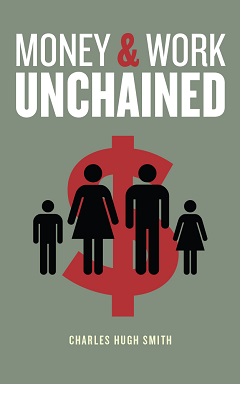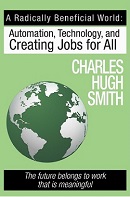And So It Begins
The hollowness of the status quo's self-correcting mechanisms is being revealed, and it's discomforting.
And so it begins. Call it whatever you want--how about the Great Unraveling for starters--and perhaps it's appropriate to discuss it on Friday the 13th, as old tales and superstitions are part of the mix.
Let's start with two superstitions that are not yet recognized as superstitions.
1. There are very smart people who will work very hard to keep the status quo glued together. It's unwise to bet against them.
2. Technology is Progress and Progress is inevitable.
These seem valid until the tide turns. As the sand castles erode and collapse, these are revealed as belief structures, not facts. We like to think smart people, technology and Progress will solve all difficulties without causing us any pain. When the tide is receding, this seems to be the case. See, problems are getting resolved, technologies are making life better, and Progress is advancing everywhere.
But beneath this veneer of confidence, buffers have thinned and long-smoldering conflicts are catching fire. Nuclear ambitions, nuclear threats--these never went away, and now the buffers containing them have eroded.
The buffers of financialization and globalization have thinned to the point that crisis management has been normalized. Rather than rebalance a corrupted economy and ship of state when the second of two credit-assets bubbles burst in 2008, the very smart people who work very hard shoved the throttle to maximum and ran the speedboat right over the reef.
Rather than accept the limits of a system geared to increase inequality and waste regardless of PR policy tweaks, to maintain the illusion of stability they gunned the engines of financialization and globalization into hyper-financialization and hyper-globalization.
The reef shredded the hull, but momentum and the mighty engines of cheap oil and money creation kept the doomed craft afloat for 16 long years. The PR machinery duped the passengers into believing this unstable hyper-state of spiraling inequality and squandering resources in the name of "growth" was not just permanent, it was inevitable.
The PR has now reached the pathetic stage of self-parody. The soil we all depend on for food has been depleted, but no worries, a robot will wander over the lifeless fields zapping weeds, so problem solved! The faith that simplistic technologies will painlessly solve complex human and ecological problems was always child-like, but grandiose egos and greed were more than enough to push this childish faith to self-parodying absurdity.
So 19 American families have the same net worth ($2. 6 trillion) as 110 million Americans--no problem, there's an app that resolves that.
Conflicts traverse a familiar landscape. Those dissatisfied with the status quo seek change, and those content with the status quo seek to distract, placate or bribe the discontented without relinquishing any of their power and perquisites.
The greater the concentration of wealth and power in a ruling elite, the greater the opportunities for delusion and catastrophic misjudgment. The concentration of power and wealth have reached extremes throughout the world, and so the stage has been set for miscalculations, clashes of ego, delusional confidences and beliefs and desperate gambles by those who can't afford to lose.
Nobody noticed--or admitted--that the buffers protecting all these forces from breaking out have been thinned by decades of destruction, fraud, corruption, waste, inequality and propaganda that everything was going just fine because it was going just fine for those at the wheel of power and wealth.
The hollowness of the status quo's self-correcting mechanisms is being revealed, and it's discomforting. All is not as it seems, and so it begins. Call it whatever you want, but hyper-normalizing it with fine-sounding cover stories won't repair the shredded hull.

My recent books:
Disclosure: As an Amazon Associate I earn from qualifying purchases originated via links to Amazon products on this site.
The Mythology of Progress, Anti-Progress and a Mythology for the 21st Century print $18, (Kindle $8.95, Hardcover $24 (215 pages, 2024) Read the Introduction and first chapter for free (PDF)
Self-Reliance in the 21st Century print $18, (Kindle $8.95, audiobook $13.08 (96 pages, 2022) Read the first chapter for free (PDF)
The Asian Heroine Who Seduced Me (Novel) print $10.95, Kindle $6.95 Read an excerpt for free (PDF)
When You Can't Go On: Burnout, Reckoning and Renewal $18 print, $8.95 Kindle ebook; audiobook Read the first section for free (PDF)
Global Crisis, National Renewal: A (Revolutionary) Grand Strategy for the United States (Kindle $9.95, print $24, audiobook) Read Chapter One for free (PDF).
A Hacker's Teleology: Sharing the Wealth of Our Shrinking Planet (Kindle $8.95, print $20, audiobook $17.46) Read the first section for free (PDF).
Will You Be Richer or Poorer?: Profit, Power, and AI in a Traumatized World
(Kindle $5, print $10, audiobook) Read the first section for free (PDF).
The Adventures of the Consulting Philosopher: The Disappearance of Drake (Novel) $4.95 Kindle, $10.95 print); read the first chapters for free (PDF)
Money and Work Unchained $6.95 Kindle, $15 print) Read the first section for free
Become a $3/month patron of my work via patreon.com.
Subscribe to my Substack for free
NOTE: Contributions/subscriptions are acknowledged in the order received. Your name and email remain confidential and will not be given to any other individual, company or agency.
|
Thank you, John F. ($70), for your splendidly generous subscription to this site -- I am greatly honored by your support and readership. |
Thank you, Bill M. ($70), for your marvelously generous subscription to this site -- I am greatly honored by your support and readership. |
|
|
Thank you, Freedman ($7/month), for your magnificently generous subscription to this site -- I am greatly honored by your support and readership. |
Thank you, Ben M. ($7/month), for your superbly generous subscription to this site -- I am greatly honored by your support and readership. |































